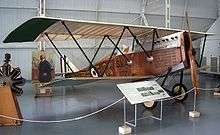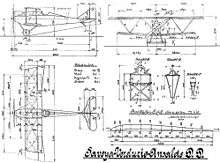Ansaldo SVA
| SVA | |
|---|---|
 | |
| SVA.5 Primo | |
| Role | Reconnaissance aircraft |
| Manufacturer | Gio. Ansaldo & C. |
| Designer | Umberto Savoia and Rodolfo Verduzio |
| First flight | 1917 |
| Number built | 1,245 |
|
| |
The Ansaldo SVA (named for Savoia-Verduzio-Ansaldo) was a family of Italian reconnaissance biplane aircraft of World War I and the decade after. Originally conceived as a fighter, the SVA was found inadequate for that role. Nevertheless, its impressive speed, range and operational ceiling, with its top speed making it one of the fastest (if not the fastest) of all Allied combat aircraft in World War I, gave it the right properties to be an excellent reconnaissance aircraft and even light bomber. Production of the aircraft continued well after the war, with the final examples delivered in 1918. Two minor variants were produced, one with reconnaissance cameras, the other without cameras but extra fuel tanks.
The SVA was a conventionally laid-out unequal-span biplane, featuring Warren Truss-style struts, and therefore having no transverse (spanwise) bracing wires. The plywood-skinned fuselage had the typical Ansaldo triangular rear cross-section behind the cockpit, transitioning to a rectangular cross section going forwards through the rear cockpit area, with a full rectangular cross section forward of the cockpit.[1]
The Flight over Vienna propaganda flight, inspired by Gabriele d'Annunzio, was carried out on August 9, 1918, by the 87th Squadriglia La Serenissima from San Pelagio, consisting of an eleven plane flight of various models of Ansaldo SVA-series biplanes. At least two of the aircraft were two seater SVA 9 or 10s to accommodate d'Annunzio himself for the flight he inspired, with the remainder being SVA 5 single-seaters.
Variants
- SVA.1 - single prototype
- SVA.2 - 65 production aircraft
- ISVA - (Idroplane - "seaplane") float-equipped version. 50 built for Italian navy
- SVA.3 - AER-built SVA.4
- SVA.3 Ridotto ("Reduced") - fast-climbing interceptor variant for anti-Zeppelin defence. Some fitted with additional oblique-firing machine gun
- SVA.4 - first major production version. Portside Vickers gun deleted to save weight for cameras.
- SVA.5 - definitive production version
- SVA.6 - prototype bomber version
- SVA.8 - single prototype; nature unclear
- SVA.9 - two-seat unarmed reconnaissance version with larger wings. Intended as pathfinder for SVA.5 formations, and as trainer
- SVA.10 - two-seat armed reconnaissance version with 250 hp Isotta-Fraschini engine and fitted with single forward firing gun and a Lewis gun on a flexible mounting in the rear cockpit
Operators

- Georgian Air Force - 10 aircraft 1920
- Yugoslav Royal Air Force - one aircraft
Specifications (SVA.5)

General characteristics
- Crew: one pilot
- Length: 8.10 m (26 ft 7 in)
- Wingspan: 9.10 m (29 ft 10 in)
- Height: 2.65 m (8 ft 8 in)
- Wing area: 24.2 m2 (260 ft2)
- Empty weight: 680 kg (1,500 lb)
- Gross weight: 1,050 kg (2,320 lb)
- Powerplant: 1 × SPA 6A, 150 kW (200 hp)
Performance
- Maximum speed: 230 km/h (140 mph)
- Range: 690 km (420 miles)
- Endurance: 3 hours
- Service ceiling: 6,000 m (19,700 ft)
- Rate of climb: 5 m/s (980 ft/min)
Armament
- 2 × synchronised .303 Vickers machine gun
- up to 90 kg (200 lb) of bombs
See also
References
- ↑ "Ansaldo SVA9". Air Progress. October 1971.
- Alegi, Gregory (1993). Ansaldo SVA 5 - Windsock Datafile 40. Hertfordshire, Great Britain: Albatros Productions Ltd. ISBN 0-9484-1450-2.
- Cattaneo, Gianni (1966). The S.V.A. (Ansaldo) Scouts - Profile Publications Number 61. Surrey, UK: Profile Publications Ltd.
- Taylor, Michael J. H. (1989). Jane's Encyclopedia of Aviation. London: Studio Editions. p. 62.
- World Aircraft Information Files. Brightstar Publishing: London. File 889 Sheet 62.
- airwar.ru
- Munson, Kenneth "Aircraft of World War I". Ian Allan 1967. ISBN 0-7110-0356-4
External links
| Wikimedia Commons has media related to Ansaldo SVA. |
| ||||||||||||||||||